The best new science fiction books of July 2025 featuring our culture editor’s pick of the year so far


Hal LaCroix’s Here and Beyond takes place on a spaceship journeying for centuries to a new planet
dotted zebra / Alamy
Riches galore await sci-fi fans in July, with two of the books I’ve enjoyed most so far this year due to be published for all to read. Fancy a beautifully written vision of a world turning ever faster, in which the consequences of this speed-up play out in subtle but increasingly disturbing ways? Try Alex Foster’s Circular Motion. Or how about a brilliant “generation ship” story? Then it’s Hal LaCroix’s Here and Beyond you’re after. Elsewhere, there’s climate fiction, zombies, space romance and a last-of-its-kind snail. Enjoy – I certainly will!
Set in the not-too-distant future, this stunningly impressive debut novel imagines an Earth orbited by massive aircraft, which allow the sufficiently wealthy to pop from New York to London in an hour, or order in sushi from Japan. Earth’s spin, meanwhile, is gradually accelerating, with days at first just a few seconds shorter but, nightmarishly, contracting to just two hours as the novel progresses, with all sorts of terrible consequences. I’ve just finished this novel and it is wonderful – maybe my top read of the year so far: disturbing, clever, beautifully written and, like all the best dystopias, it makes me even more grateful for the world I live in now, spinning at a sensible rate.
I love a good “generation ship” story, and this is a cracker, set after life on Earth has collapsed, with 600 people setting out on a 360-year journey through space to a new planet. Generations must live on Shipworld before they arrive, though, and Hal LaCroix shows us the difficulties that mount for those on board, from disease to rebellions to some travellers who come to doubt that they are even on a ship at all. Don’t just take my word for its brilliance, though: our sci-fi reviewer Emily H. Wilson has also given it a firm thumbs up, and her taste is impeccable (or, at least, it aligns strongly with mine!).
It is scorching in London as I write this, so a vision of a dystopian future from Susanna Kwan, set in a future San Francisco where it has rained for years, actually sounds rather appealing. We follow Bo, whose family and friends have fled a city destroyed by terrible floods. Bo lives alone high above the streets that have become rivers. She’s about to leave on a ship, but when her elderly neighbour Mia asks for help, she decides to stay behind. This novel is being compared to Emily St. John Mandel’s literary dystopia Station Eleven and to Eleanor Catton’s climate-activist thriller Birnam Wood, both of which I loved, so I’m keen to immerse myself in Kwan’s world of rain.

Susanna Kwan’s Awake in the Floating City takes place in a flooded future San Francisco
Bulgac/Getty Images
We’re already exploring a quickly turning Earth, a destroyed Earth, and a rainy Earth in this month’s sci-fi. Now we have a version of Earth from An Yu in which the sun is slowly disappearing. This novel is set in a small village surrounded by deserts and follows two sisters struggling to survive. As temperatures drop, the inhabitants of the village realise they are all going to die – until the Beacons appear, “ordinary people with heads replaced by searing, blinding light, like miniature suns”. Intriguing!
Kezza is an acrobat in the Martian circus, living a hard life, when she discovers a “sinister secret”. A thousand years later, Azad is living on the desert planet of Nabatea but joins some space-travelling historians to find out why his ancestors left Mars.
This climate fiction novel (I’m not going to adopt the “cli-fi” moniker as I strongly dislike it) is set in 2056, in a self-sufficient community on a remote Welsh island, established to avoid the authoritarian government’s “Clearances”. But 13-year-old Glesni thinks her family is hiding something, especially when someone from the mainland washes ashore.
Pitched by the publisher as perfect for fans of Gabrielle Zevin’s Tomorrow and Tomorrow and Tomorrow, this follows Zoe and Jack, who meet as chemistry students at Harvard. Two years later, they’ve dropped out to join a company promising longer life – but the venture will test their love for each other “to its very limit”.
I admit this might not quite class as sci-fi, but bear with me: it is a road-trip novel, set in 2022 Ukraine, involving “maverick scientist” Yeva and Lefty, a “last-of-his-kind snail with one final shot at perpetuating his species”. Yeva’s passion is trying to breed rare snails, and she funds her work by dating men who come to Ukraine on “guided romance tours” looking for “docile brides”. “Brilliant … funny and smart, full of science, longing and adventure,” says Ann Patchett in her write-up. I think the science, and the endling snail, means it slips in here as something sci-fi fans would enjoy.
There aren’t enough zombie novels out there, in the opinion of this superfan of The Walking Dead. Thankfully Leigh Radford is out to combat this dearth, with the tale of a scientist whose husband was the last person to be bitten in a zombie pandemic. As the government rounds up and disposes of the infected, our scientist Kesta keeps a dangerous secret: her zombie husband, Tim, is tied to her bed to prevent him rampaging, while she tries to find him a cure… A fun twist on the tale – although Rick Grimes would have offed Tim in a heartbeat, just saying…
I have this on my to-read pile and I’m looking forward to it. Erlick imagines an experimental treatment centre where the broken-hearted can go to sleep through their pain, waking only when they are healed. Of course, there are some “shadowy side effects”, and we follow four strangers (and a dog: Wizard of Oz territory here for sure) on their way to the Poppy Fields, seeking healing from heartache.
Described by its publisher as a “sapphic sci-fi action adventure novella,” Volatile Memory features Wylla, who discovers a lucrative bit of tech on a nearby planet. The tech turns out to be the corpse of a woman wearing an AI mask that has brought her back to life – a woman who “sees Wylla in a way no one ever has.” The pair set out to find some answers…

In Emily Buchanan’s Send Flowers, a woman’s dead boyfriend is reincarnated as a house plant
ozgurcankaya/Getty Images
In a world on the brink of climate collapse, eco-influencer Fiona has stayed in her flat since her boyfriend Ed died. But when his favourite plant is left on her doorstep, she sprinkles his ashes into the soil – and wakes the next day to find that not only has it flowered, but it can talk. Ed is back – as a houseplant.
Topics:
Source link




